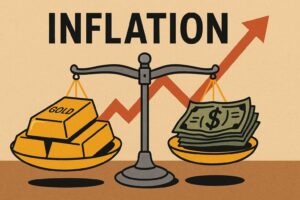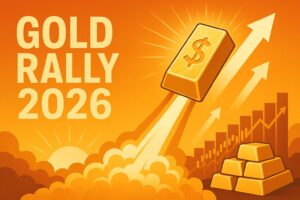
The spot price of gold changes minute by minute, reflecting a constant tug-of-war between markets, policies, and global risks. For investors, the key is recognizing the major gold price drivers that sit beneath those price swings. Understanding these dynamics doesn’t just explain where gold has been — it helps reveal where it could go next, and how it can strengthen a diversified investment strategy.
The gold spot price moves minute by minute during trading hours, shaped by economic data, central bank decisions, and global events. Below, we’ll break down the five most important gold price drivers that consistently move markets.
1. Federal Reserve Interest Rate Decisions and Monetary Policy
The Federal Reserve remains the single biggest influence on gold. When interest rates rise, gold often faces downward pressure, since higher yields on Treasuries and savings accounts make non-yielding assets less attractive. But when the Fed cuts rates or signals a dovish path, gold demand tends to jump.
The nuance here is that it’s not just the rate changes themselves — it’s the expectations. Traders parse every Fed speech, dot plot, and meeting minute for hints about future moves. Even a subtle shift in tone, such as suggesting inflation is “sticky” or the economy is “cooling,” can move gold instantly.
We’ve also entered a new playbook. Historically, rising real rates would have crushed gold, but recent years have shown that even with higher rates, gold can surge if investors believe those hikes undermine debt sustainability or threaten recession. This shift is critical: it means monetary policy isn’t just a headwind — it can also be a tailwind depending on the broader context.
2. US Dollar Strength and Currency Fluctuations
Because gold is priced in US dollars globally, the dollar’s strength acts like a seesaw for the metal. When the dollar rises, gold typically falls, since it becomes more expensive for international buyers. On the flip side, when the dollar weakens, gold demand usually increases as it becomes more affordable outside the US.
Traders and long-term investors alike keep a close eye on the Dollar Index (DXY), which measures the dollar against a basket of major currencies like the euro, yen, and pound. Sharp moves in the DXY often foreshadow corresponding swings in gold prices.
It’s also important to remember that currency dynamics aren’t limited to the dollar. In emerging markets like India and China — two of the largest gold consumers — local currency weakness against the dollar can supercharge demand. That’s because gold becomes a safer alternative to holding depreciating paper money.
Simply put, the US dollar is one of the most powerful gold price drivers. Whether it’s rising or falling, the ripple effects are felt across every corner of the global gold market.
3. Inflation Data and Economic Indicators
Gold’s reputation as an inflation hedge is one of the main reasons investors hold it. When inflation runs hot, cash loses purchasing power, making gold a more attractive store of value. Reports like the Consumer Price Index (CPI) and Producer Price Index (PPI) are closely watched because they often spark immediate reactions in gold markets.
But there’s a twist. If high inflation leads the Fed to hike aggressively, short-term gold demand can weaken as higher yields compete for capital. However, if inflation stays high and the Fed falls behind the curve — as it has at times in history — gold often breaks out to new highs.
Other indicators matter too: GDP growth, unemployment, and consumer confidence all shape expectations for inflation and Fed policy. Weak data can raise recession fears, sending investors to gold for safety. Strong data, meanwhile, can temporarily reduce gold’s appeal but often doesn’t erase its long-term value as a hedge.
For investors, inflation data is more than a headline — it’s a pulse check on the economy and a core trigger for gold’s role in preserving wealth.
4. Geopolitical Events and Market Risk Sentiment
Gold’s role as the “crisis commodity” makes it highly sensitive to global headlines. Wars, trade disputes, sanctions, and political instability can all drive sudden surges in demand. When uncertainty spikes, gold typically rallies.
Recent examples show this clearly: Russia’s invasion of Ukraine accelerated central bank buying, while Middle East tensions have repeatedly triggered flight-to-safety trades. Political instability — whether in Washington, Brussels, or Beijing — can have the same effect, shaking confidence in paper assets and fueling demand for gold.
Investors also track the VIX (the volatility index), which often rises in tandem with gold during market stress. In times of crisis, gold doesn’t just preserve wealth — it can outperform equities, currencies, and bonds, proving why it remains a cornerstone of diversified portfolios.
5. Central Bank Gold Purchases and Institutional Demand
One of the most important but sometimes overlooked gold price drivers is official-sector demand. Central banks, particularly in emerging markets like China, Turkey, and India, have been steadily increasing their reserves. Since 2022, global central bank buying has hit record levels, creating a price floor that is less sensitive to short-term market noise.
Institutional flows also play a key role. Exchange-traded funds (ETFs) like GLD act as barometers of institutional appetite for gold. When ETF holdings rise, it signals strong inflows that can accelerate upward momentum. Conversely, large outflows can put temporary pressure on prices.
Add to this the positioning of commercial banks and hedge funds, visible in the Commitment of Traders (COT) reports, and you get a clearer picture of professional sentiment. Together, these large players can amplify price moves well beyond what retail demand alone might drive.
Tracking Gold Price Movements
For investors monitoring these factors, gold price charts provide real-time insights into how these drivers affect actual market pricing. Understanding bullion premiums is equally important when considering physical gold purchases, as premiums can vary based on demand conditions and supply chain factors.
Strategic Takeaways for Investors
Gold’s price isn’t random. It reflects the constant tug-of-war between these five drivers: Fed policy, the dollar, inflation data, geopolitical risk, and institutional demand. Sometimes they work in harmony, other times they collide—creating the volatility that makes gold such a dynamic asset.
For conservative investors, these fundamentals reinforce gold’s role as a hedge and stabilizer. For tactical traders, they offer signals for short-term positioning. Either way, staying alert to the gold price drivers is key to making smarter, more timely investment decisions.
FAQs on What Drives Gold?
What are the main gold price drivers?
The main gold price drivers are Federal Reserve interest rate policy, US dollar strength, inflation data, geopolitical risk, and central bank or institutional demand. These five forces consistently shape gold’s spot price by influencing investor sentiment, demand flows, and safe-haven buying.
How do Federal Reserve interest rates affect gold prices?
When the Federal Reserve raises interest rates, gold often comes under pressure as yield-bearing assets become more attractive. But rate cuts—or even dovish Fed signals—tend to boost gold demand. In today’s environment, even rising rates can support gold if investors believe they threaten debt sustainability or increase recession risk.
Why does the US dollar impact gold prices?
Gold is priced globally in US dollars, so the dollar’s strength or weakness directly affects its demand. A strong dollar makes gold more expensive for overseas buyers, often pushing prices lower. A weaker dollar has the opposite effect, increasing global demand and providing a tailwind for gold.
Is gold a good hedge against inflation?
Yes. Gold has historically served as one of the most reliable hedges against inflation. When inflation erodes the purchasing power of paper money, investors turn to gold as a store of value. However, aggressive Fed rate hikes in response to inflation can temporarily weigh on gold prices.
How do central banks influence gold prices?
Central banks are among the largest buyers of gold, and their purchases have hit record levels in recent years. Because these purchases are less price-sensitive, they provide structural support for the market. When combined with institutional flows into gold ETFs, central bank buying is a powerful force that can set long-term price trends.
Get Gold & Silver Insights Direct to Your Inbox
Join thousands of smart investors who receive expert analysis, market updates, and exclusive deals every week.




![Is Now the Best Time to Buy Silver? [Silver 2025–2030 Forecasts]](https://goldsilver.com/wp-content/uploads/2025/11/price-of-silver-300x155.jpg)




